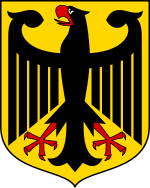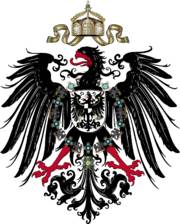Coat of arms of Germany
| Coat of arms of Germany | |
 |
|
| Versions | |
|---|---|

The Eagle used by federal institutions
|
|
| Details | |
| Armiger | The German Federal Government |
| Escutcheon | Or an eagle sable, armed, beaked and langued gules. |
| Earlier versions | The current version of the coat of arms of Germany was introduced during the later days of the Weimar Republic |
The coat of arms of Germany is a symbol of Germany; the coat of arms feature an eagle. The colors of the coat of arms are similar to those of the flag of Germany (black, red and gold). It is one of the oldest extant state symbols of Europe and is one of the oldest insignias in the world.
Contents |
Medieval Age and Holy Roman Empire

The eagle's history as an emblem began very early. The Romans and their successors Byzantines (Greeks) reserved eagle imagery for only the most revered beings; namely, the supreme god and the emperor; and it served as a metaphor of invincibility. Later, through its rei rock eagle (adler), referred to in German as the Reichsadler, on German soil probably date back to the time of Charlemagne (742-814). Around the year 1200 the black eagle icon on a gold field was generally recognised as the imperial coat of arms.
In 1433 the double-headed eagle was adopted for the first time by the Holy Roman Emperor Sigismund. Since then the double-headed eagle came to be used as the symbol of the German emperor, and hence as the coat of arms of the Holy Roman Empire of the German Nation. From the middle of the 15th century onwards, the respective emperors put the emblem of their dynasty on the eagle's chest. After the end of the Holy Roman Empire of the German Nation in 1806, a German state and a unified state emblem ceased to exist.
| Coats of Arms of the Holy Roman Empire | |||
|---|---|---|---|
 |
 |
 |
 |
| Coat of Arms of Emperor Frederick III. as German King in 1446. | The Arms of the Holy Roman Empire of the German Nation in a manuscript | The Arms of Emperor Joseph II. (1765) | The Arms 1804 - 1806 under the last Emperor Francis II. (Emperor Francis I. of Austria) |
German Confederation
In 1815, a German Confederation (Bund) of 39 loosely-united German states was founded on the territory of the former German empire. Until 1848, the confederation did not have a coat of arms of its own. The Federal Diet (Bundestag) meeting at Frankfurt am Main used a seal which carried the emblem of the Austrian Empire, since Austria had taken over the union's leadership. It showed a black, double-headed eagle, which Austria had adopted just before the dissolution of the Holy Roman Empire of the German Nation.
During the 1848 revolution, a new Reich coat of arms was adopted by the German National Assembly that convened in St. Paul's Church in Frankfurt. The black double-headed eagle was retained, but without the four symbols of the emperor: the sword, the imperial orb, the sceptre and the crown. The eagle rested on a golden shield; above was a five-pointed golden star. On both sides the shield was flanked by two flags with the colours black-red-gold. The emblem, however, never gained general acceptance.
| Coats of Arms in the times of the German Confederation | |||
|---|---|---|---|
 |
 |
 |
|
| Imperial Eagle of Austria served as model for the Arms of the German Confederation | Coat of Arms of the German Confederation | Proposed Coat of Arms of the German Empire during the March Revolution 1848 | |
North German Confederation

In 1867, the North German Confederation was established without Austria and the southern German states, and under the leadership of the Kingdom of Prussia (see coat of arms of Prussia). A new coat of arms was adopted, which consisted of a shield with the colours black-white-red, flanked by two wild men holding cudgels and standing on a pedestal.
German Empire
The German Empire re-introduced the Medieval single headed eagle in a golden shield. The so called Reichsadler, was already introduced at the Proclamation of Versailles, althogh the first version had been only a provisional one. The design of the eagle had been altered at least two times during the German Empire (1871-1918).
| The Coats of Arms of the German Empire (1871-1918) | |||
|---|---|---|---|
 |
 |
 |
 |
| The Greater Coat of Arms of the German Emperor: Imperial Coat of Arms of His Majesty | Provisional arms of the German Empire at the Proclamation of Versailles
27. April 1871–3. August 1871 |
The Coat of Arms of the German Empire, 1871 - 1889
3. August 1871–1888 |
The Coat of Arms of the German Empire, 1889 - 1918
6. December 1888–1918 |
Weimar Republic
The Weimar Republic (1918-1933), retained the Reichsadler without the symbols of the former Monarchy (Crown, Collar, Breast shield with the Prussian Arms).
| The Coats of Arms of the Weimar Republic (1919-1933) | |||
|---|---|---|---|
 |
 |
||
| Arms in the earlier days of the Weimar Republic | Arms used in the governmental flags of the Weimar Republic | ||
Nazi Germany
When Adolf Hitler came to power in 1933, the Weimar eagle was retained until 1935. The Nazi party used an rather aggressively styled black eagle above a highly stylised oak wreath, with a swastika at its centre. When the eagle is looking to its left shoulder, it symbolises the Nazi party, and was therefore called the Parteiadler. After 1935 the Nazis introduced their party symbol as the national insignia (Hoheitszeichen) as well. This version symbolises the country (Reich), and was therefore called the Reichsadler. It can be distinguished from the Parteiadler because the eagle is looking to its right shoulder.
| Insignia during Nazi-rule (1933-1945) | |||
|---|---|---|---|
 |
|||
| The Reichsadler during the time of Nazi rule, representing Nazi Germany as a national insignia (Hoheitszeichen) since 1935 |
|||
Post-War Era
After the defeat of Germany in World War II, the German Reich continued to exist under Allied occupation until the Federal Republic of Germany was founded in 1949. In 1950, the Federal Republic incorporated the Weimar eagle, which thenceforward was called the Bundesadler ("federal eagle"), into its coat of arms. The design by Tobias Schwab dates from 1926. Since the accession of the German Democratic Republic in 1990, the Federal Eagle has been the state symbol of the reunified Germany.
German Democratic Republic
- Main arcticle: Coat of arms of the German Democratic Republic
The German Democratic Republic (East Germany) used a socialist insignia from 1950 until its merger with West Germany in 1990. In 1959 the insigna was also added to the Flag of East Germany.
| Insignia of the German Democratic Republic | ||
|---|---|---|
 |
||
| Coat of Arms of East Germany 1950–1953 |
Coat of Arms of East Germany 1953–1955 |
Coat of Arms of East Germany 1955–1990 |
Current usage
Official depictions of the eagle can be found not only in the federal coat of arms but also on the federal institutions flag, the standard of the President of Germany and official seals. These are designs by various artists of the Weimar period and differ primarily in the shape and position of the wings. A large and very plump version of the eagle decorates the chamber of the Bundestag, the German parliament, it is sometimes called "Fette Henne" (Fat Hen), with a similar representation found on the Euro coin. In addition to the official depictions, artistic renderings of the federal eagle are permitted and have found their way onto coins, stamps and the letterhead of federal authorities.
Gallery of variants
 |
 |
 |
 |
 |
|
| The coat of arms as used by the government of the Federal Republic of Germany | The Eagle in the Bundesschild (Federal badge) used on government flags | Presidential Standard | The Eagle used by federal institutions | The Eagle on the German Mark coin (until 2002) | The Eagle on the German 1 euro coin |
|---|
See also
- List of coats of arms of Germany
- Origin of the coats of arms of Germany and its federal states
|
|||||||||||
|
|||||||||||